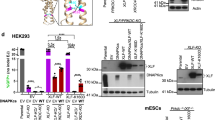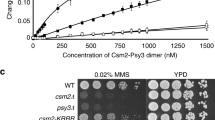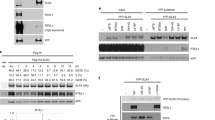Abstract
DNA double-strand breaks are repaired by homologous recombination or DNA end-joining, but the latter process often causes illegitimate recombination and chromosome rearrangements. One of the factors involved in the end-joining process is Hdf1, a yeast homologue of Ku protein1,2,3,4. We used the yeast two-hybrid assay to show that Hdf1 interacts with Sir4, which is involved in transcriptional silencing at telomeres and HM loci5,6. Analyses of sir4 mutants showed that Sir4 is required for deletion by illegitimate recombination and DNA end-joining in the pathway involving Hdf1. Sir2 and Sir3, but not Sir1, were also found to participate in these processes. Furthermore, mutations of the SIR2, SIR3 and SIR4 genes conferred increased sensitivity to γ-radiation in a genetic background with a mutation of the RAD52 gene, which is essential for double-strand break repair mediated by homologous recombination. These results indicate that Sir proteins are involved in double-strand break repair mediated by end-joining. We propose that Sir proteins act with Hdf1 to alter broken DNA ends to create an inactivated chromatin structure that is essential for the rejoining of DNA ends.
This is a preview of subscription content, access via your institution
Access options
Subscribe to this journal
Receive 51 print issues and online access
$199.00 per year
only $3.90 per issue
Buy this article
- Purchase on Springer Link
- Instant access to full article PDF
Prices may be subject to local taxes which are calculated during checkout


Similar content being viewed by others
References
Tsukamoto, Y., Kato, J. & Ikeda, H. Hdf1, a yeast Ku-protein homologue, is involved in illegitimate recombination, but not in homologous recombination. Nucleic Acids Res. 24, 2067–2072 (1996).
Tsukamoto, Y., Kato, J. & Ikeda, H. Budding yeast Rad50, Mre11, Xrs2, and Hdf1, but not Rad52, are involved in formation of deletion mutation on a dicentric plasmid. Mol. Gen. Genet.(in the press).
Milne, G. T., Jin, S., Shannon, K. B. & Weaver, D. T. Mutations in two Ku homologs define a DNA end-joining repair pathway in Saccharomyces cerevisiae. Mol. Cell Biol. 16, 4189–4198 (1996).
Boulton, S. J. & Jackson, S. P. Saccharomyces cerevisiae Ku70 potentiates illegitimate DNA double-strand break repair and serves as a barrier to error-prone DNA repair pathways. EMBO J. 15, 5093–5103 (1996).
Laurenson, P. & Rine, J. Silencers, silencing, and heritable transcriptional states. Microbiol. Rev. 56, 543–560 (1992).
Shore, D. in Telomeres(eds Blackburn, E. H. & Greider, C. W.) 139–191 (Cold Spring Harbor Laboratory Press, NY, (1995)).
Tsukamoto, Y., Kato, J. & Ikeda, H. Effects of mutations of RAD50, RAD51, RAD52, and related genes on illegitimate recombination in Saccharomyces cerevisiae. Genetics 142, 383–391 (1996).
Feldmann, H. & Winnacker, E. L. Aputative homologue of the human autoantigen Ku from Saccharomyces cerevisiae. J. Biol. Chem. 268, 12895–12900 (1993).
Weaver, D. T. What to do at an end: DNA double-strand-break repair. Trends Genet. 11, 388–392 (1995).
Boulton, S. J. & Jackson, S. P. Identification of a Saccharomyces cerevisiae Ku80 homologue: roles in DNA double strand break rejoining and in telomeric maintenance. Nucleic Acids Res. 24, 4639–4648 (1996).
Siede, W., Friedl, A. A., Dianova, I., Eckardt-Schupp, F. & Friedberg, E. C. The Saccharomyces cerevisiae Ku autoantigen homologue affects radiosensitivity only in the absence of homologous recombination. Genetics 142, 91–102 (1996).
Liang, F., Romanienko, P. J., Weaver, D. T., Jeggo, P. A. & Jasin, M. Chromosomal double-strand break repair in Ku80-deficient cells. Proc. Natl Acad. Sci. USA 93, 8929–8933 (1996).
Chien, C. T., Bartel, P. L., Sternglanz, R. & Fields, S. The two-hybrid system: a method to identify and clone genes for proteins that interact with a protein of interest. Proc. Natl Acad. Sci. USA 88, 9578–9582 (1991).
Sikorski, R. S. & Hieter, P. Asystem of shuttle vectors and yeast host strains designed for efficient manipulation of DNA in Saccharomyces cerevisiae. Genetics 122, 19–27 (1989).
Broach, J. R., Strathern, J. N. & Hicks, J. B. Transformation in yeast: development of a hybrid cloning vector and isolation of the CAN1 gene. Gene 8, 121–133 (1979).
Petes, T. D., Malone, R. E. & Symington, L. S. in The molecular and Cellular Biology of the Yeast Saccharomyces. Genome Dynamics, Protein Synthesis, and Energetics Vol. 1(eds Broach, J. R., Pringle, J. R. & Jones, E. W.) 407–521 (Cold Spring Harbor Laboratory Press, NY, (1991)).
Pilus, L. & Rine, J. Epigenetic inheritance of transcriptional states in S. cerevisiae. Cell 59, 637–647 (1989).
Aparicio, O. M., Billington, B. L. & Gottschling, D. E. Modifiers of position effect are shared between telomeric and silent mating-type loci in S. cerevisiae. Cell 66, 1279–1287 (1991).
Moazed, D. & Johnson, D. Adeubiquitinating enzyme interacts with SIR4 and regulates silencing in S. cerevisiae. Cell 86, 667–677 (1996).
Moretti, P., Freeman, K., Coodly, L. & Shore, D. Evidence that a complex of SIR proteins interacts with the silencer and telomere-binding protein RAP1. Genes Dev. 8, 2257–2269 (1994).
Palladino, F.et al. SIR3 and SIR4 proteins are required for the positioning and integrity of yeast telomeres. Cell 75, 543–555 (1993).
Porter, S. E., Greenwell, P. W., Ritchie, K. B. & Petes, T. D. The DNA-binding protein Hdf1p (a putative Ku homologue) is required for maintaining normal telomere length in Saccharomyces cerevisiae. Nucleic Acids Res. 24, 582–585 (1996).
Sussel, L. & Shore, D. Separation of transcriptional activation and silencing functions of the RAP1-encoded repressor/activator protein 1: isolation of viable mutants affecting both silencing and telomere length. Proc. Natl Acad. Sci. USA 88, 7749–7753 (1991).
Buck, S. W. & Shore, D. Action of a RAP1 carboxy-terminal silencing domain reveals an underlying competition between HMR and telomeres in yeast. Genes Dev. 9, 370–384 (1995).
Rothstein, R. J. One-step gene disruption in yeast. Methods Enzymol. 101, 202–211 (1983).
Thomas, B. J. & Rothstein, R. Elevated recombination rates in transcriptionally active DNA. Cell 56, 619–630 (1989).
Hollenberg, S. M., Sternglanz, R., Cheng, P. F. & Weintraub, H. Identification of a new family of tissue-specific basic helix-loop-helix proteins with a two-hybrid system. Mol. Cell. Biol. 15, 3813–3822 (1995).
Rose, M. D., Winston, F. & Hieter, P. Methods in Yeast Genetics, a Laboratory Course Manual(Cold Spring Harbor Laboratory Press, NY, (1990)).
Luria, S. E. & Delbruck, M. Mutations of bacteria from virus sensitivity to virus resistance. Genetics 28, 491–511 (1943).
Lea, D. E. & Coulson, C. A. The distribution of the numbers of mutants in bacterial populations. J. Genet. 49, 264–285 (1948).
Acknowledgements
We thank S. Fields, S. M. Hollenberg, K. Johzuka, I. Kobayashi, A. Miyajima, J. Rine and J. W. Szostak for providing plasmids and strains, and K. Johzuka for advice on the two-hybrid assay. This work was supported in part by grants to Y.T., J.K. and H.I. from the Ministry of Education, Science, Sports, and Culture of Japan. Y.T. was supported by a postdoctoral fellowship of the Japan Society for the Promotion of Science.
Author information
Authors and Affiliations
Corresponding author
Rights and permissions
About this article
Cite this article
Tsukamoto, Y., Kato, Ji. & Ikeda, H. Silencing factors participate in DNA repair and recombination in Saccharomyces cerevisiae. Nature 388, 900–903 (1997). https://doi.org/10.1038/42288
Received:
Accepted:
Issue Date:
DOI: https://doi.org/10.1038/42288
This article is cited by
-
Auxin-mediated protein depletion for metabolic engineering in terpene-producing yeast
Nature Communications (2021)
-
Resveratrol treatment reveals a novel role for HMGB1 in regulation of the type 1 interferon response in dengue virus infection
Scientific Reports (2017)
-
Dimerization of Sir3 via its C-terminal winged helix domain is essential for yeast heterochromatin formation
The EMBO Journal (2013)
-
Repressive and non-repressive chromatin at native telomeres in Saccharomyces cerevisiae
Epigenetics & Chromatin (2009)
-
Yeast Rap1 contributes to genomic integrity by activating DNA damage repair genes
The EMBO Journal (2008)
Comments
By submitting a comment you agree to abide by our Terms and Community Guidelines. If you find something abusive or that does not comply with our terms or guidelines please flag it as inappropriate.



